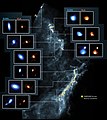| Molecular cloud | |
|---|---|
| dark nebula | |
 Lynds 1641 (below the Orion Nebula) seen by the Atacama Pathfinder Experiment and DSS2 Lynds 1641 (below the Orion Nebula) seen by the Atacama Pathfinder Experiment and DSS2 | |
| Observation data: J2000.0 epoch | |
| Right ascension | 05 39 00.0 |
| Declination | −07° 00′ 00″ |
| Distance | 1249-1477 ly (383-453 pc) |
| Constellation | Orion (constellation) |
| Designations | Lynds 1641 |
| See also: Lists of nebulae | |
LDN 1641 or Lynds 1641 is a dark cloud in the constellation Orion. It encompasses a large part of the Orion A molecular cloud in the Orion molecular cloud complex, which is the closest giant molecular cloud to earth. At its northern end it is connected to the Orion Nebula and at its southern end it is connected to the dark cloud LDN 1647. LDN 1641 contains more than a thousand young stellar objects (YSOs). It is a relative low density star-forming region without any massive O- or B-type stars that could disturb the formation of young stars with their ultraviolet radiation. This means that researchers can study star formation that is happening in a very different environment when compared to the Orion Nebula.
Star-formation began in Lynds 1641 about 2-3 million years ago. About 50% of the YSOs in Lynds 1641 have circumstellar disks of which many were directly imaged with ALMA. The YSOs have a large fraction (21%) of so-called transitional disks, which are disks with a gap. Many of the directly imaged disks of other stars appearing in news coverage are in much closer star-forming regions, such as the Scorpius-Centaurus association. The disks will appear much smaller in ALMA images because of the 4 times larger distance compared to such a region.
Lynds 1641 has a strong distance gradient. The southern part of the cloud lies at around 428±10 parsec and the Orion Nebula lies at 388±5 parsecs according to VLBA observations. Gaia data has shown that the stars of Orion A follow a trend towards a closer distance at the northern part of the dark cloud. A distance of about 453 parsecs for the southern end of LDN 1641 and a distance of about 383 parsecs at the northern end of LDN 1641 was measured with Gaia.
Other nebulae overlap with Lynds 1641 and are associated with it, such as NGC 1999, IC 427/428, IC 429/430, HH34 and HH 1/2.
Gallery
-
 Orion Nebula (top bright cloud) and Lynds 1641 (bottom dark clouds) with the Digitized Sky Survey 2
Orion Nebula (top bright cloud) and Lynds 1641 (bottom dark clouds) with the Digitized Sky Survey 2
-
 Orion A (bottom) with Herschel. Yellow points of the bottom cloud show the position of young stellar objects in Lynds 1641. The bottom three disks are in Lynds 1641.
Orion A (bottom) with Herschel. Yellow points of the bottom cloud show the position of young stellar objects in Lynds 1641. The bottom three disks are in Lynds 1641.
-
 Herschel Space Observatory image of Lynds 1641 (orange) and the Orion Nebula (middle circle, white) and Sh2-279 (top circle, white).
Herschel Space Observatory image of Lynds 1641 (orange) and the Orion Nebula (middle circle, white) and Sh2-279 (top circle, white).
References
- ^ "LDN 1641". SIMBAD. Centre de données astronomiques de Strasbourg. Retrieved 2022-09-28.
- ^ Großschedl, Josefa E.; Alves, João; Meingast, Stefan; Ackerl, Christine; Ascenso, Joana; Bouy, Hervé; Burkert, Andreas; Forbrich, Jan; Fürnkranz, Verena; Goodman, Alyssa; Hacar, Álvaro; Herbst-Kiss, Gabor; Lada, Charles J.; Larreina, Irati; Leschinski, Kieran (2018-11-01). "3D shape of Orion A from Gaia DR2". Astronomy and Astrophysics. 619: A106. arXiv:1808.05952. Bibcode:2018A&A...619A.106G. doi:10.1051/0004-6361/201833901. ISSN 0004-6361. S2CID 53705897. Archived from the original on 2022-03-08. Retrieved 2022-09-28.
- ^ Maddalena, R. J.; Morris, M.; Moscowitz, J.; Thaddeus, P. (1986-04-01). "The Large System of Molecular Clouds in Orion and Monoceros". The Astrophysical Journal. 303: 375. Bibcode:1986ApJ...303..375M. doi:10.1086/164083. ISSN 0004-637X.
- ^ Fang, Min; Kim, Jinyoung Serena; van Boekel, Roy; Sicilia-Aguilar, Aurora; Henning, Thomas; Flaherty, Kevin (2013-07-01). "Young Stellar Objects in Lynds 1641: Disks, Accretion, and Star Formation History". The Astrophysical Journal Supplement Series. 207 (1): 5. arXiv:1304.7777. Bibcode:2013ApJS..207....5F. doi:10.1088/0067-0049/207/1/5. hdl:10486/662090. ISSN 0067-0049. S2CID 54190607. Archived from the original on 2022-09-28. Retrieved 2022-09-28.
- ^ Grant, Sierra L.; Espaillat, Catherine C.; Wendeborn, John; Tobin, John J.; Macías, Enrique; Rilinger, Anneliese; Ribas, Álvaro; Megeath, S. Thomas; Fischer, William J.; Calvet, Nuria; Hee Kim, Kyoung (2021-06-01). "An ALMA Survey of Protoplanetary Disks in Lynds 1641". The Astrophysical Journal. 913 (2): 123. arXiv:2103.16453. Bibcode:2021ApJ...913..123G. doi:10.3847/1538-4357/abf432. ISSN 0004-637X. S2CID 232417752.
- Fang, Min; Kim, Jinyoung Serena; van Boekel, Roy; Sicilia-Aguilar, Aurora; Henning, Thomas; Flaherty, Kevin (2013-07-01). "Young Stellar Objects in Lynds 1641: Disks, Accretion, and Star Formation History". The Astrophysical Journal Supplement Series. 207 (1): 5. arXiv:1304.7777. Bibcode:2013ApJS..207....5F. doi:10.1088/0067-0049/207/1/5. hdl:10486/662090. ISSN 0067-0049. S2CID 54190607. Archived from the original on 2022-09-28. Retrieved 2022-09-28.
- Grant, Sierra L.; Espaillat, Catherine C.; Megeath, S. Thomas; Calvet, Nuria; Fischer, William J.; Miller, Christopher J.; Kim, Kyoung Hee; Stutz, Amelia M.; Ribas, Álvaro; Robinson, Connor E. (2018-08-01). "Herschel Observations of Protoplanetary Disks in Lynds 1641". The Astrophysical Journal. 863 (1): 13. arXiv:1806.06825. Bibcode:2018ApJ...863...13G. doi:10.3847/1538-4357/aacda7. ISSN 0004-637X. S2CID 119295714.
- Kounkel, Marina; Hartmann, Lee; Loinard, Laurent; Ortiz-León, Gisela N.; Mioduszewski, Amy J.; Rodríguez, Luis F.; Dzib, Sergio A.; Torres, Rosa M.; Pech, Gerardo; Galli, Phillip A. B.; Rivera, Juana L.; Boden, Andrew F.; Evans, Neal J. II; Briceño, Cesar; Tobin, John J. (2017-01-01). "The Gould's Belt Distances Survey (GOBELINS) II. Distances and Structure toward the Orion Molecular Clouds". The Astrophysical Journal. 834 (2): 142. arXiv:1609.04041. Bibcode:2017ApJ...834..142K. doi:10.3847/1538-4357/834/2/142. hdl:1887/59417. ISSN 0004-637X. S2CID 26439367.